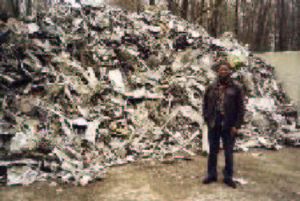
A local reference: a foundry in Cameroon
The descriptive material contained in this document has been compiled primarily with help from a smalltime craftsman in Cameroon, Yaoundé from which we can say that:
- Its production can occasionally reach 400 kg/week of molten metal with charcoal as a fuel;
- The products consisted mainly of kitchen equipment, pots in all sizes, ladles, strainers ...
- The raw material used was aluminum-waste
- The merger was carried out in a melting pot furnace
- The area available for the production plant was reduced.
This artisan sought primarily to improve the quality of its products, which has been the reason for the intervention. The analysis of other information sources cited in the Appendices, as well as contacts with some experts in the industry, local and in Europe, have also helped to open up other coarses of action. It was possible to put in practice the principles studied during simulations in the workshop prior to local intervention. Methods and manuals listed below are not new, nor revolutionary. The approach is made of methods that were known and were used well before those of the era of space technology, but they have disappeared from workshops in the northern countries, due to profitability in an economic and social context which is theirs. On the other hand, one finds here and there, in sub-Saharan Africa for example, elements of appropriate technologies possible here. It was possible to apply them in a local context, such as with the local partner in Cameroon, while making improvements possible. These technologies must be able to help craftsmen of aluminum foundries to engage in this type of activity to improve the quality of its products and possibly be able to diversify his stock. The emphasis is on technologies limiting the supply of components or machinery or import products. And this by example for the manufacturing of:
- kitchen utensils,
- simple machine parts: wheels, pulleys, parts for farm equipment, ...
- decorative items such as medals, nameplates, ...
The site, building, premises[edit | edit source]
The site[edit | edit source]
In its simplest form, the production site will house the equipment and have following functions:
- Storage of raw material, aluminum recovery
- Storage of sand
- Fuel storage, in Cameroon usually charcoal
- Drying of sand in the sun
- Assembly of the wooden frame designated to contain the sand that will provide the footprint of the part to be fabricated
- Cleaning, reduction, sorting and storage of aluminum materials by category, separating at least the heavy pieces from the light ones, the heavy ones containing generally alloying elements in larger quantities, are more quickly melted than the light pieces and are melted first
- Realization of the sand mold
- Melting in a melting pot-type furnace
- Pouring into the molds
- Finishing with cutting, trimming and polishing tools
- Storage of unused frames, storage of raw materials such as secondary talc or wood ash, storage of tools.
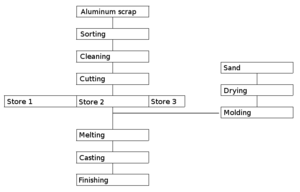
The extent of the site and buildings is varies heavily depending on:
- the size of parts to manufacture and therefore the mold and the que to create
- availability of the workshop which may be only rented by day
- The storage possibilities
- rainfall and humidity in the location ...
Production sites seen in Cameroon[edit | edit source]
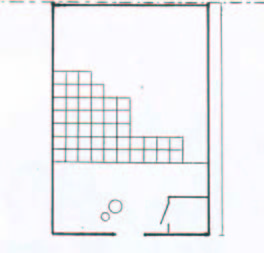
The workshop which was reviewed and to which reference was made in the introduction, is situated in Yaoundé, in the district of Tsinga, where the productive aluminum foundries are concentrated; it includes a building with the following characteristics: Land available ~ 130 m² Corrugated iron building structure Ground surface building 9x6m² Height ~ 3 m Sloping roof The building provides the storage of sand, furnace, mold manufacturing, the sand molds awaiting casting and store secondary materials. The smoke is blown out through the door and a few openings in the sidewalls. The site is leased to various smelters on a dayly basis. O: furnace o: hole in the event of the breaking of square melting pots: molds, local tools Here, we produce pots in dimensions of about 300mm diameter in quantities of approximately 100 pieces in a work day with a melting pot of a capacity close to 600 kg. Other small craftsmen from the same neighborhood have their furnace vented without a lid. This limits production to days without rain, in the dry season it obviously doesn't pose problems. In Douala, where the climate is much wetter than Yaoundé, in the New-Bell neighbourhood, the furnace is shielded with many craftsmen.
Improvements to implement in the workshop building[edit | edit source]
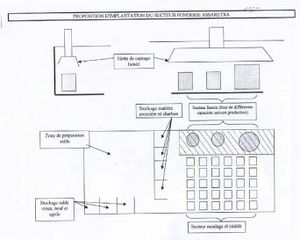
The main problems mentioned regarding the facilities are the following:
- Risk of explosion upon contact with melted metal and rain, if the furnace is not sheltered
- Exposure of staff to smoke
- Lack of space for storage and sorting of the raw material, it is brought on the day of production, the workshops do not belong to the smelters and are leased for the day.
- High risk of theft, especially as the workshops are concentrated in a single district outside of populated areas.
We can address the first two by placing the furnace in a more ventilated premise, separated by an enclosure, the furnace is not ultimately protected from rain than by a large canopy. The size of it, however, must consider the danger of explosion that may be created by contact of water with molten aluminum. A more expensive solution would be to have over the furnace:
- A hood with ventilation of the combustion fumes to the outside.
- A scheme incorporating the casting of the night, limits the risk of theft of raw material. A group of craftsmen allows rotating cooperative work, monitoring is exerted by the workmen not occupied by the melting work itself.
Appropriate process used[edit | edit source]
The process includes the following 7 operations:
- Gathering, cleaning, cutting and sorting of waste
- Drying of the sand
- Manufacturing of frames and molds
- Molding
- Fusion
- Casting
- Finish by trimming and polishing.
In Cameroon, the last operation, finishing, is traditionally done in other specialized workshops. Many small-scale foundries often do not occupy themselves in sorting and cleaning materials, or drying sand.
Gathering, cleaning and sorting of waste[edit | edit source]
Gathering: The basic raw material consists of scrap (waste) reclaimed from public landfill sites, or directly from users of aluminum, such as garages, for example, often in a state of unacceptable dirtyness. This scrap consist of a variety of objects. (In the appendix, we find an illustrative list.) Composition chemistry of the cast alloy is likely to be highly variable, depending on the manufacturing plant, and the melting temperature of the mixture.
Cleaning: Must be executed to the highest possible degree to avoid impurities and unnecessary takeup of pollutants:
- fats and oils and plastic parts which, in the casting, degrade by releasing toxic fumes
- the parts containing copper which, after melting, form a metal are best avoided for culinary applications: corrosion caused by water penetrates the walls and can release a hazardous copper oxide
- Metal items (screws, springs, rivets, ...)
Required installation: a free surface for manual removal of paints and other coatings of scrap parts, and plastic parts. Using a magnet which approaches the surface of the material placed on the soil, we may eliminate a number of steel parts, and we may avoid the inclusion of iron as well.
Sorting:

For the sake of fuel economy when merging, separating the large pieces such as housings, lighter engine parts, such as profilés, the latter being less likely to contain elements of alloys in large quantities, which would be otherwise molten as well at higher temperature. They will be enfournées in the melting pot, thereafter. Installation requirements: a surface covered with a inclined sheet on which can be placed; downwards facing drain holes, containers and pieces containing oil. This sheet is inclined towards a chute collecting the oil and pouring it in a container.
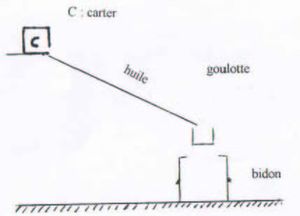
Cutting of raw materials: We should primarily try to reduce the size of the scrap in order to introduce them in the melting process, by means of small machines. Facilities/tools needed:
- Shears, a simple machine, in appendix, suitable for profiles and plates
- Oxy-acetylene torch (garage type) for thick parts,
- Metal saws, hammer or weight
- Separate storage locations for the different categories of materials
first aluminum: the heavy, and light parts. Areas separated by walls of wood or concrete.
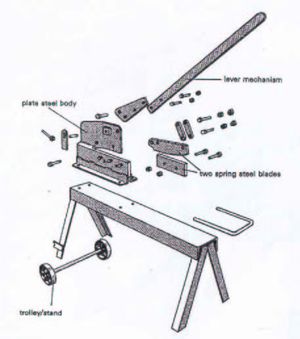
The treatment of the sand[edit | edit source]
The type of sand used
The sand must be a siliceous sand, ie with a very high percentage of silica. River sand is not sufficient. A <<à vert>> sand, with a composition approximatly as follows is suitable for the creation of the mold: Silica 80-90% Clay 8-15% Water 4%, (can be a little more, 6%, depending on the ambient temperature). The size of the sand affects the state of the part's surface: a fine sand provides a smooth surface. This size is generally characterized by an index called AFS. A value of 95 AFS provides an acceptable result locally (see Appenix 9). This sand is obtained either crude (containing clay), or by the mixture of highly silicieus sand which we enriches with clay in the form of bentonite, in order to obtain the proper composition. We can approximately determine the clay content of a natural silicious sand by the following test: Material:
- A transparent long and narrow glass, such as a small jar with screw lid, of 10-15 cm high
- Possibly a support to keep the container vertically.
Procedure:
- Fill up halfway with foundry sand
- Complete with water to fill the container entirely
- Shake well
- Let stand for one day: the silica settles gently on the bottom, itself topped by the clay, and topped with a layer of silt.
- Measure the height of the deposit below the silica.
- Comparing with the total height of the solid gives the percentage of silica in the sand.
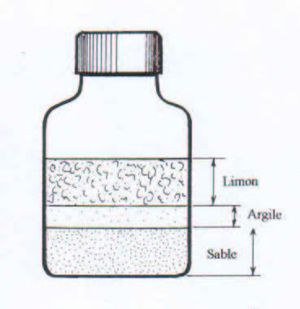
After each use, the sand must be allowed to pass again through the sieve to avoid lumps and possibly aluminum burrs which are accidentally present. To improve the surface of the skin of the piece, we can possibly provide for two qualities of sand. A finer sand in contact with the part and another one for coarser calibration and maintenance of the first. If the sand improves the surface condition of the piece, sand setting promotes the evacuation of gas by the micro-channels they burrow in the casting. The present coarse sand always exercises this function to facilitate the evacuation of gas. However, this technique requires more frequent renewal of the sand, because by its use, the two types are mixed. This reduces the ability of the calibration sand to evacuate the gas.
Drying, storing and sifting of the sand
Ideally, according to European criteria, the foundry sand should contain but 2 percent water, which is difficult to achieve in tropical climates. We must therefore use dry sand with H2O rates close to: 4% for clay content, with a maximum of 10% 6% for clay content, with a maximum of 15%
A simple device is used to measure it. On the other hand the weight of a quantity of sand before and after drying in a thin layer of 1cm max. near a furnace and sheet metal, can also infer with the moisture content. Drying sand for the molds can be done by exposure to sunlight through spreading it as a thin layer on a metal sheet during perhaps half an hour to 1 hour as follows:
- A floor space is covered with sheets of aluminum
- The sand is spread in a thin layer of 7 cm, prostrate to the sun and stirred up regularly to expose the lower layers which tend to absorb the moisture of the upper layers
- The storage of dry sand should be done out of reach of rain and humidity, in one or two tanks or closed tanks to enable easier rotation of their content and to maintain an acceptable moisture content, the water has the tendancy to drop to the bottom of the tank.
Apparent density of the sand pile: 1.6 - 1.7 Before each use, the sand will be sieved through a sieve with a mesh of about 1 mm.
Manufacturing of frames and molds[edit | edit source]
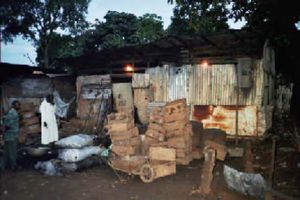
The frame is usually in steel or cast iron, and can be achieved more economically by wooden boards of a standard thickness of 12 mm assembled by nails. The dimensions of these frames are based on those of the molding piece, the position of the joint of the two half molds, the position of the attacks and casting channels. The height depends on the condition of the part to achieve. There must be a height least 150 mm above the highest point of the molding piece, so as to contain the thrust of the liquid metal at the end of the filling of the mold.
To facilitate removal, the boards at one of the 4 angles can be unified by a cord instead of nails, which can facilitate the demolding. Some theoretical basis for calculating the footprint of the piece: Linear shrinkage of the Aluminum: 1.2 to 1.4% Volumetric shrinkage: 8% by volume Remains: 3.5% These values must be confirmed by tests on a case by case basis.
Channels for the flow of molten aluminum is primarily inspired on following rules:
- Funnel-shaped cone slightly bent to avoid the whirling of the liquid and therefore the entering of air into the mold
- Descent with section Sd, decreasing from top to bottom
- Horizontal channel section with trapezoidal height = 2 times the width
- Attacks of thick plates of 2 or 3mm
- Vents in the upper part of the piece, in section Se with a total of Se=Sd for evacuating the gases contained within the imprint
Compliance ratios: Channel section/Descending section ≥ 1.2 Sum of attack sections/ Descending sections ≥ 2 In appendix, you will find complementary guide values.
Casting[edit | edit source]
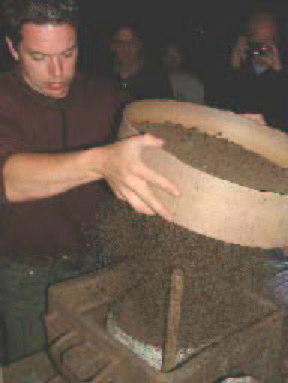
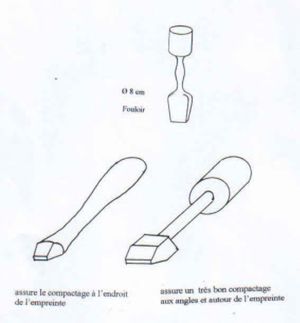
The preliminary operations: Sifting of sand on top of the frame through a sieve cloth with apertures of about 1 mm.
Adjustment of water content; classical test applied by the molder: "Take a handful of sand, strongly compress it in the hand, if the hand opens again, the sand will keep the design of the fingers distinctively, it contains enough water." Compaction using a rammer and then the foot, bearing the full weight of the body on the sand.
Ground molding for a drop cast by means of a single frame[edit | edit source]
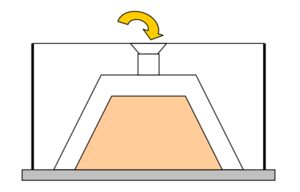
This is the easiest method to create the mold. It is practiced particularly in India, Egypt and sub-Saharan Africa (Cameroon, Benin, ...). Described in the appendix, it is justified only in special cases and only gives very average results.
Ground molding for a source casting by means of a single frame[edit | edit source]
In this process, called source casting, the metal fills the imprint of the mold from the foot towards the top.
Casting descent Casting channel Flowing attacks Events Attack channels Grime
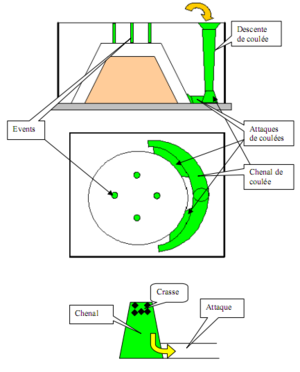
For the molding of kitchen utensils such as pots, in a general external form as cylindrical or conical-trunk form, a mold can be achieved as described and illustrated below:
- Creation of a sand bed, plan of 3 to 4 cm thick on the ground of the workshop
- Dispersal of the interior of the model by talc or wood ash finely molded to allow the demolding
- Filling of the sand-pot model, clamping (settlement), to the brim with the rammer, obviously to reduce the load to handle.
- Laying of this latter on the bed, with the edge facing downwards,
- Laying down the descent model and the channel model
- Installation of frame
- Filling of the frame with sand,
- Compaction, and tightening by the rammer, and then with the foot
- Whole of the funnel and attacks in the sand, the attacks and the channel can be made with a model as well
- Demoulding of the attacks and the model
- Lisser of sand and breaking of the edges
- Perforating of events <<pencils>>.
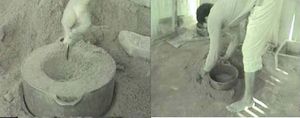
Filling the hollow part of the pot with sand. Clamping and releasing the whole together.
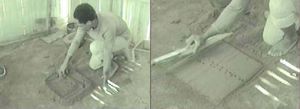
Production of a sand bed of 3 to 4 cm in thickness and with top surface facing the frame.This sand bed will therefore act as bottom of the mold.
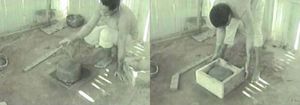
Setting up of the pot on the sandbed and a wooden frame.
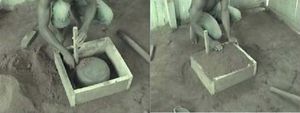
Positioning of a tube of wood that will serve as a model for the descent. The sand must be well clamped at the base to keep the timber in position. Filling of the mold with sand.
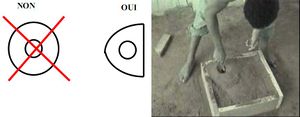
We measure the funnel that requires to have one side to the right (see diagram left - topview of the funnel) to avoid creating a vortex that pulls in air and dirt to the imprint.
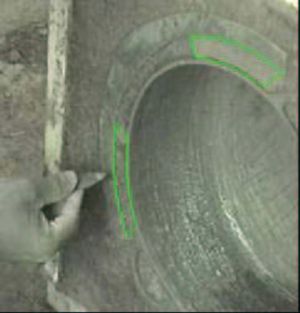
We measure the attacks
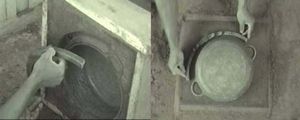
Demoulding of the channel that could be made either out of the upper mold (left) or in the lower part (right)
Molding by source casting with two frames.
Casting of a skillet
This is the most common encountered method in the northern countries. For cooking equipment, it can be performed not on the ground, but on a workbench. This technique can be used to cast a french skillet shape of the brand "Tefal" with a slope at the panhandle. Note; In a large production, it is clear that there should be a quantity of molds for the amount of melting capacity of the melting pot or duration of the working day ...